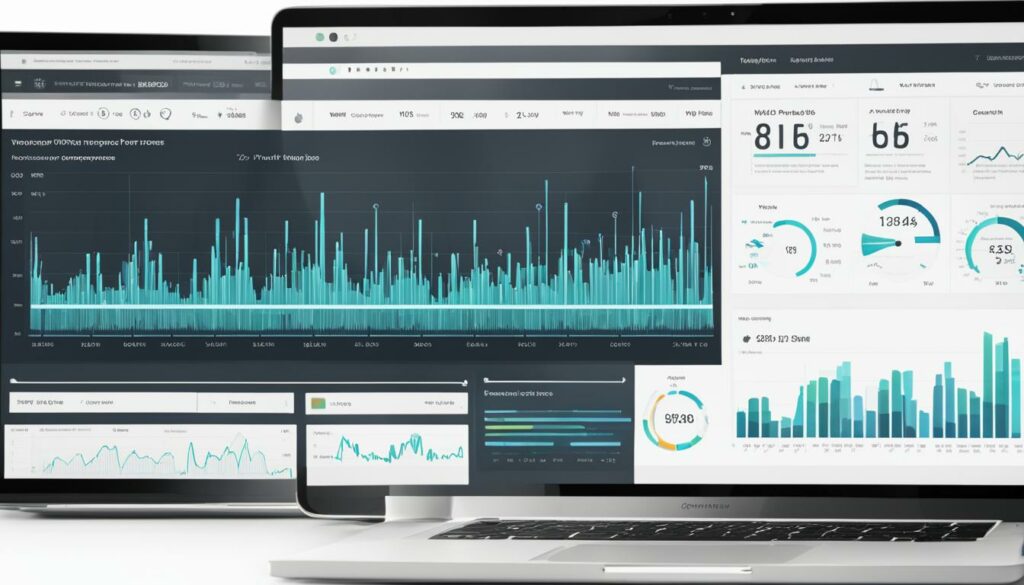Monitoring the performance of your WordPress site is crucial to ensure it is running smoothly and providing a good user experience. When it comes to website performance, you can’t afford to be complacent. By constantly monitoring and optimizing your site’s performance, you can improve WordPress speed, optimize website speed, and provide a seamless browsing experience for your visitors.
Fortunately, there are numerous tools available to help you monitor and optimize your WordPress performance. These tools provide insights into various performance metrics, such as page load times, server response times, and overall website health. By utilizing these tools, you can identify and address any issues that may be affecting your site’s performance, and proactively optimize it for better speed and user experience.
Key Takeaways:
- WordPress performance monitoring is essential for ensuring your site runs smoothly and provides a good user experience.
- Monitoring your site allows you to track various performance metrics and identify areas for improvement.
- Optimizing your WordPress performance can improve website speed and user engagement.
- There are plenty of performance monitoring tools available to help you monitor and optimize your WordPress site.
- Consider WordPress hosting options, like BoostedHost, for optimal performance.
Why Monitor Your WordPress Website?
Monitoring your WordPress website is essential for several reasons. Firstly, it helps you identify and fix any issues or errors that may be affecting the performance of your site. This includes things like slow loading times, downtime, and server response issues. By monitoring your site, you can detect and resolve these issues quickly, ensuring your site is always running smoothly.
Monitoring also allows you to track and analyze various performance metrics, such as page load times, user engagement, and conversion rates. This data can help you identify areas for improvement and optimize your site for better performance and user experience.
For instance, by monitoring your website’s performance, you can:
- Improve WordPress speed by identifying and resolving issues that may be causing slow loading times.
- Optimize website speed by analyzing user engagement metrics and making adjustments to improve the overall user experience.
- Monitor website performance to ensure your site is always responsive and accessible to visitors, reducing the risk of losing potential customers or users.
- Identify performance bottlenecks and take appropriate actions to enhance the performance of your WordPress site.
In short, monitoring your WordPress website allows you to proactively address performance issues, optimize your site to provide a better user experience, and ultimately achieve your website goals.
Boost your WordPress site’s performance with BoostedHost. Sign up now for WordPress Hosting from BoostedHost at www.boostedhost.com/wordpress-hosting.
Key Metrics to Monitor
When monitoring your WordPress website, there are several key metrics you should pay attention to:
- Page Load Time: The speed at which your web pages load is crucial for providing a smooth user experience. Slow loading times can lead to high bounce rates and decreased user satisfaction. Monitor your page load time to ensure it falls within acceptable limits.
- Server Response Time: The time it takes for your server to respond to a user’s request can significantly impact website performance. Aim for a low server response time to minimize delays and improve overall site speed.
- Website Availability: Downtime can be detrimental to your website’s success. Monitor your website’s availability to ensure it is accessible to users at all times. Regularly check for any server issues or maintenance that may cause downtime.
- Mobile Responsiveness: With the increasing use of mobile devices, it’s crucial that your website is mobile-friendly and provides a seamless experience across different screen sizes. Monitor your website’s mobile responsiveness to identify any issues that may affect mobile users.
- Error Rate: Keep an eye on the number of errors occurring on your website, such as broken links or missing images. Minimize errors to improve user experience and avoid negative impacts on search engine rankings.
- User Engagement: Monitoring user engagement metrics such as bounce rate, time on page, and click-through rate can provide insights into how users are interacting with your website. Use this data to optimize your content and design for better user engagement.
Note: Remember, the above metrics are just a starting point. Depending on your specific goals and website requirements, you may want to monitor additional metrics such as conversion rates, traffic sources, and social media engagement.

Sign up for BoostedHost’s WordPress Hosting to ensure optimal performance and monitoring of your website. Click here to get started!
Top WordPress Performance Monitoring Tools
When it comes to monitoring the performance of your WordPress website, having the right tools is essential. These WordPress performance monitoring tools provide valuable insights and metrics to help you optimize your site’s speed and overall performance. Here are some of the top tools you should consider:
1. Pingdom
Pingdom is a popular website monitoring tool that offers real-time monitoring of your WordPress site’s uptime and performance. It provides detailed reports and alerts whenever your site experiences downtime or slowdowns. Pingdom also offers comprehensive performance metrics and page speed analysis, allowing you to identify areas for improvement and optimize your site.
2. GTmetrix
GTmetrix is a powerful performance monitoring tool that analyzes your WordPress site’s speed and provides detailed reports on various performance metrics. It measures your site’s page load times, waterfalls, and grades your site based on Google’s PageSpeed and Yahoo’s YSlow rules. GTmetrix also offers recommendations to help you optimize your site’s speed and performance.
3. New Relic
New Relic is a comprehensive monitoring tool that offers deep insights into your WordPress site’s performance. It provides real-time data on server response times, database queries, and overall application performance. New Relic also offers analytics and reporting to help you identify and troubleshoot performance bottlenecks.
4. Google Analytics
While Google Analytics is primarily known for its website analytics capabilities, it also offers valuable performance monitoring features. With Google Analytics, you can track important metrics like page load times, bounce rates, and user engagement. This data can help you identify performance issues and make informed decisions to optimize your site’s performance.
5. Uptime Robot
Uptime Robot is a reliable tool for monitoring your WordPress site’s uptime and availability. It sends regular checks to your website and alerts you immediately if your site goes down. Uptime Robot also provides performance data, response times, and downtime reports to help you ensure your site is always up and running smoothly.
Monitoring the performance of your WordPress website is crucial for providing a seamless user experience and improving your site’s search engine rankings. These top WordPress performance monitoring tools give you the insights and data you need to optimize your site’s speed and performance.
Secure Your WordPress Site
In addition to monitoring the performance of your WordPress website, it’s essential to prioritize its security. With the increasing number of cyber threats, protecting your site from potential attacks is crucial for maintaining its integrity and safeguarding sensitive data. WordPress security plugins provide an extra layer of defense by offering a range of features specifically designed to keep your site secure from malware, hacking attempts, and spam.
These security plugins offer numerous benefits, including:
- Active security monitoring: Continuous monitoring of your site’s security ensures that any suspicious behavior or malicious activities are promptly detected and addressed.
- File and malware scanning: Regular scans of your WordPress files and databases help identify and remove any malware or compromised files that could harm your site.
- Blocklist monitoring: Integration with blocklist services enables the detection and blocking of IP addresses or domains associated with known malicious activities.
- Security hardening: Implementing recommended security measures within your WordPress site, such as enforcing strong passwords, limiting login attempts, and protecting sensitive files, helps fortify your defenses against potential attacks.
- Post-hack actions: In the unfortunate event that your site is compromised, WordPress security plugins provide tools to assist with remediation, recovery, and preventing future incidents.
By utilizing robust WordPress security plugins, you can significantly enhance the security posture of your website, mitigating potential risks and ensuring the safety of your visitors’ data. It’s crucial to select a reputable security plugin that offers comprehensive features and regular updates to stay ahead of evolving threats.
| WordPress Security Plugin | Key Features |
|---|---|
| Wordfence Security |
|
| iThemes Security |
|
| Sucuri Security |
|
Remember, protecting your WordPress site is an ongoing process. Alongside using security plugins, it’s crucial to practice good security hygiene by regularly updating WordPress, themes, and plugins, using strong and unique passwords, and conducting regular backups of your site’s files and database.
We recommend WordPress Hosting from BoostedHost for optimal performance and enhanced security. With their secure hosting environment, advanced server protection, and automatic backups, you can ensure your WordPress site is well-protected against potential security threats. Sign up now through this link: www.boostedhost.com/wordpress-hosting.

Best WordPress Security Plugins
When it comes to protecting your website from potential security threats, investing in the right WordPress security plugins is crucial. These plugins offer an array of features designed to enhance the security of your WordPress site, safeguarding it against malware, hacking attempts, and other vulnerabilities. Here are some of the best WordPress security plugins available:
| Plugin Name | Key Features |
|---|---|
| Wordfence Security |
|
| Sucuri Security |
|
| iThemes Security |
|
These plugins are highly regarded in the WordPress community for their effectiveness in safeguarding websites. Remember, website security is not something to be taken lightly. By installing and configuring these security plugins, you can provide an additional layer of protection, ensuring the safety of your site and the privacy of your users’ data.

Prioritizing Website Security
When it comes to website security, prevention is key. Protecting your WordPress site from potential threats is crucial to ensure the safety of your data and maintain the trust of your visitors. By prioritizing website security, you can proactively safeguard your website and protect it from malicious attacks. Here are some essential steps you should take to enhance the security of your WordPress site:
Implement Security Best Practices
Start by implementing security best practices that serve as the foundation for a secure website. Strong passwords play a vital role in preventing unauthorized access, so make sure to use complex and unique passwords for your WordPress login. Regularly update your WordPress core, themes, and plugins to patch any vulnerabilities and protect against potential exploits. Additionally, limit the number of plugins you install and regularly review and remove any unused or outdated plugins.
Regularly Back Up Your Files and Database
Backing up your website regularly is crucial in case of a security breach or data loss. By creating regular backups of your site’s files and database, you can quickly restore your website to a previous state if necessary. Ensure that your backups are stored securely in an off-site location for maximum protection.
Choose a Secure Hosting Provider
The choice of your hosting provider plays a significant role in your website’s security. Opt for a reputable WordPress hosting provider like BoostedHost that offers secure hosting solutions specifically designed for WordPress websites. Such hosting providers often include built-in security measures, like firewalls, malware scanning, and DDoS protection, to protect your site from common threats.
Partner with a Reliable WordPress Security Plugin
Enhance the security of your WordPress site by utilizing a reliable security plugin. WordPress security plugins provide an extra layer of defense against potential threats, such as malware, hacking attempts, and spam. These plugins offer features like active security monitoring, malware scanning, security hardening, and post-hack actions to mitigate the impact of any security breaches.
To ensure the utmost security for your WordPress site, we recommend WordPress Hosting from BoostedHost. With their secure hosting environment, advanced security measures, and reliable WordPress security plugins, you can rest assured that your website is protected from potential threats. Sign up now through this link: www.boostedhost.com/wordpress-hosting.
By prioritizing website security and following these best practices, you can safeguard your WordPress site and provide a secure online environment for your visitors and users.
Conclusion
Monitoring the performance and ensuring the security of your WordPress website are crucial for providing a seamless user experience and protecting your site from potential threats. By using WordPress performance monitoring tools, you can track and optimize various metrics like page load times, server response time, and user engagement. This allows you to identify and fix any issues that may be affecting your site’s performance.
In addition to performance monitoring, it’s also vital to prioritize website security. Utilizing WordPress security plugins adds an extra layer of protection against potential threats, such as malware, hacking attempts, and spam. These plugins provide active security monitoring, file and malware scanning, blocklist monitoring, security hardening, and post-hack actions.
When it comes to WordPress hosting, we recommend BoostedHost for optimal performance. Their secure hosting environment ensures the safety of your website along with excellent performance. Sign up now through this link: www.boostedhost.com/wordpress-hosting and secure your WordPress site with their reliable hosting services.
FAQ
Q: Why is it important to monitor the performance of your WordPress website?
A: Monitoring the performance of your WordPress website is crucial to ensure it is running smoothly and providing a good user experience. It helps identify and fix any issues or errors that may be affecting its performance, including slow loading times and server response issues. Monitoring also allows you to track and analyze performance metrics, identifying areas for improvement and optimizing your site for better performance.
Q: What are the key metrics to monitor for WordPress website performance?
A: The key metrics to monitor for WordPress website performance include page load times, server response time, user engagement metrics like bounce rate and time spent on site, conversion rates, and website uptime.
Q: What are some top WordPress performance monitoring tools?
A: Some top WordPress performance monitoring tools include New Relic, Pingdom, GTmetrix, Google PageSpeed Insights, and Kinsta APM.
Q: How can WordPress security plugins help secure my website?
A: WordPress security plugins offer additional layers of protection against potential threats, such as malware, hacking attempts, and spam. They provide features like active security monitoring, file and malware scanning, blocklist monitoring, security hardening, and post-hack actions to help enhance the security of your WordPress site.
Q: What are some best WordPress security plugins?
A: Some best WordPress security plugins include Wordfence Security, Sucuri Security, iThemes Security, and All In One WP Security & Firewall.
Q: How do I prioritize website security for my WordPress site?
A: Prioritizing website security involves implementing security best practices like using strong passwords, keeping WordPress and plugins updated, regularly backing up your site’s files and database, and choosing a secure hosting provider that offers built-in security measures. Additionally, partnering with a reliable WordPress security plugin can further enhance your site’s security.












